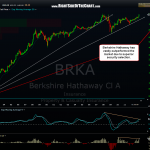 I’ve written about the benefits of trading stocks vs. the market in the past. In my opinion, it’s very difficult to beat the market by trading the market. Warren Buffet didn’t grow Berkshire Hathaway by 2600% over the last 22 years by trading the SPY, QQQ & IWM. He did so via superior stock selection. Hedge fund manager John Paulson didn’t make $5 billion (personally) in 2010 buying and holding SSO or SDS, he did so by both going long & short stocks that year and mostly with his $4 billion in profits from shorting the sub-prime mortgage market in 2007. (Shorting is not evil, anti-American, etc… as Bubble-TV would have you believe.)
I’ve written about the benefits of trading stocks vs. the market in the past. In my opinion, it’s very difficult to beat the market by trading the market. Warren Buffet didn’t grow Berkshire Hathaway by 2600% over the last 22 years by trading the SPY, QQQ & IWM. He did so via superior stock selection. Hedge fund manager John Paulson didn’t make $5 billion (personally) in 2010 buying and holding SSO or SDS, he did so by both going long & short stocks that year and mostly with his $4 billion in profits from shorting the sub-prime mortgage market in 2007. (Shorting is not evil, anti-American, etc… as Bubble-TV would have you believe.)
Quite a bit of market commentary is posted on Right Side of the Chart, some with short-term predictions of where the market might go along with a lot of longer-term analysis that might not be of much use to active traders focused on the near-term trend but hopefully useful to longer-term traders and investors concerned with where it might headed over the next 6-12 months. While it is important, or even imperative to have an opinion on the future direction of the market in order to most efficiently align your trades or investments with the trend, it is also important to realize that your market analysis, as well as mine or anybody else’s for that matter, will often be wrong. This is where playing the most attractive patterns, long or short, can have it’s advantages.
If you ask just about any active or semi-active trader what the most recent trend in the market has been they will most likely say “up”. However, ask those same people how they were positioned before that huge two-day rally on Dec 31st & Jan 2nd and I’m willing to bet that the majority where not positioned fully long, at least not until after that holiday rally that caught most traders, longs and shorts alike, by surprise. Since that big 2-day rally, as most metrics reflect, we have seen a big increase in bullishness and a very sharp decline bearishness (as measured by fund inflows, bull-bear sentiment surveys, the $VIX, etc…) All around; everything that I’ve read, hear on TV, emails that I receive from fellow traders, etc.. confirms this extreme shift. However, since the close on Jan 2nd. the S&P 500 is only up a whopping 2 1/2% while the Nasdaq 100 is flat (actually down 0.2% since the Jan 2nd close as I type).
Based on the returns (or lack-thereof) above, anyone who succumbed to all the bullish cheer-leading a la Jim Cramer et al., and “bought” the market (via the SPY or QQQ) after the New Year rally, doesn’t really have much to show for it. Just picking a random number, I decided to look at a dozen of the last individual active trades added on RSOTC.com (excluding the recent QID & TWM trades, which are broad index tracking etfs, so will be excluded for the sake of this example). For balance, I looked the last 6 longs and the last 6 shorts that triggered an entry (from a previous setup) or directly posted as an active trade. Of the last 6 triggered shorts: TASR, NTRI, AMZN, ELLI, HLF, and CBK, all but AMZN are profitable (and AMZN is less than 1% above the entry price) while CBK was stopped out for a loss. Of the last 6 triggered longs: AMKR, WLT, NIHD, CVU, PWE, and XSD; all are profitable except for WLT & PWE. WLT is down less that 1% from entry is PWE is literally trading 1 cent below entry.
I do understand the reasoning and allure to trade the broad markets, especially for less experienced investors and traders. When you buy the SPY etf, you are essentially buying 500 of the largest, well capitalized companies in the US. However, just realize that when you buy (or short) the SPY, you are also buying the worst (best) performing companies in the index with the most bearish (bullish) charts. Trading broad index tracking etf’s does have some advantages over trading individual stocks, primary the relative safety in diversification. The odds of waking up to a 10%+ gap down on the SPY when you are long is extremely low while the odds of waking up to the wrong side of a 10%+ gap on an individual stock, especially a small or mid-cap company, although low, is significant enough to make proper position sizing and diversification (amongst various positions and possible even long/short hedging exposure at time) critical when swing trading or investing in individual stocks.
I do plan to write more on position sizing and diversification later but I did want to talk on the benefits of trading the most attractive looking chart patterns, long or short (for those comfortable shorting) regardless of where you “think” the market is headed.

